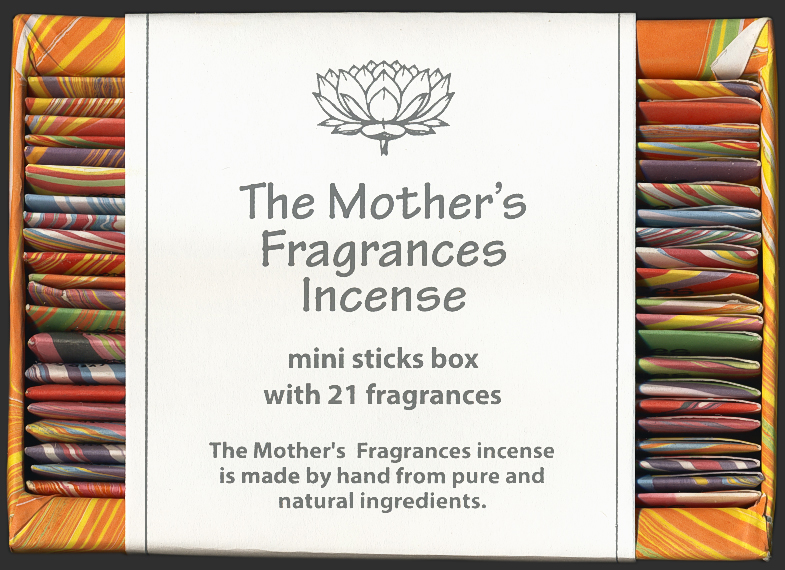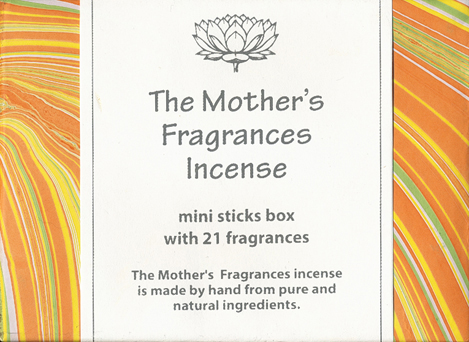The Mother’s Fragrances Incense – Regular Line – Mini Sticks Box with 21 Fragrances | Part 2: Wood and Spices

Here is the second part of the Regular Line Sampler. These incense sticks are dry masalas. Their smells are a little more complex than those of the floral varieties of the sampler, the reviews of which you can find here. Plus, they all have a certain spiciness to their base that is very distinctive. Unfortunately, if you try them one after the other, it creates a slight impression of monotony, but some of the scents benefit greatly from this spicy undertone.
| Name | Scoring Range | Description |
|---|---|---|
| Amber | 4 range | Deep, dark, balsamic-sweet and very spicy and warm. In my mind’s eye, they take me to a fair stall that sells roasted almonds and candy floss. I keep smelling a hint of a note that makes me think of agarwood, but at the same time I doubt that any is used. The agarwood-ish smell makes them similar to Spicewood. I wonder what that is. These, along with the Patchouli, are my favourites in this line. |
| Autumn Leaves | 2-3 | I was particularly excited about this one, as “Autumn Leaves” is usually known as a classic Japanese incense stick scent theme, e.g. from the renowned brand Shoyeido. Maybe it was because I had high expectations, but I was initially rather disappointed. They mainly smell like the warm, spicy, almost hot base note that the dry masalas in this line have in common in varying strengths. However, with a little more smoke smell than the others, and a somewhat funky undertone, which I got from several Japanese sticks, e.g. Kin-Kaku (Golden Pavilion) by Shoyeido. I haven’t figured out what it is yet, but I can’t stand this particular note. At the same time, in this composition it manages to evoke images of wet autumn leaves and the spicy, warm sweetness reflects the pleasant feeling when you return from cold, wet weather into a comfortably heated home. I now like them as much as Cinnamon & Spice, which they are similar to. |
| Cinnamon & Spice | 2-3 | I liked Cinnamon & Spice better at the beginning, but they were also one of the first I tried. I chose them right at the beginning to “get rid of” them, as I usually don’t like cinnamon incense sticks. So with those, it’s the opposite of Autumn Leaves: low expectations, positive surprise. They are pleasantly warm and spicy. In cold weather, I find they smell a bit more smoky. Directly compared to Autumn Leaves, they are less sweet, more powdery – almost dry and they have a musky aspect. They are more subtle, not quite as deep as AL, but not weaker. Over time, their spiciness increases. I’ll have to re-buy both to decide which one I like better. |
| Frankincense | 2-3 | These are similar to other incense sticks called “Frankincense” (by BERK and Pure, for example), of which none smell like actual Frankincense to me. But with these Frankincense sticks, I at least have the impression that I can detect a hint of the spiciness of Indian frankincense (Boswellia serrata). They have a peculiar sweetness. The aroma gives me the feeling of an “oily texture”. Of all the “Frankincense” sticks, these were my favourite so far (followed by Holy Smokes‘ offering from the Blue Line). |
| Musk | upper 2 range | Musk, like the other masalas in this line, are also warm and spicy. I don’t smell any animalic notes, just a fine, tart tone. They are rather powdery, ambery. A dry aroma, with a subtle sweetness and an interesting freshness that comes through occasionally, and of which I can’t decide whether I think of it as “green” or not. |
| Myrrh | 3 range | I don’t know whether it’s the weather, another external influence, or simply my nose what makes me perceive the smell of these sticks so differently from one time to the next. At the beginning, I smelled a bitter undertone that would be quite typical for myrrh. The second time, I found the smell very dry and woody; I was reminded of a wooden shed with sunburned boards. On the last two occasions, there was a peculiar spicy-fresh note in the foreground, which I noticed throughout the whole burn, but not as the main feature. Like the others, they have a certain warm, spicy tone and a reserved sweetness. I find them quite balanced and interesting, and I like them a little more every time I burn them. To my surprise, I now even prefer it to Frankincense. |
| Opium | 1 range | I recently read on Incense in the Wind Steve Pereira’s theory that Opium in incense (although often illustrated that way) has nothing to do with opium poppies or the opium drug, but rather with the perfume created by Yves Saint Laurent in 1977. Opium incense sticks imitate its composition. I find that very plausible. The list of fragrances used in it sounds heavenly. Unfortunately, I have found every opium incense stick unbearable so far, and these are no exception. I didn’t even burn a half of one mini stick. The smell has a certain woodiness and spice to it, with an underlying acidity that hides behind a thick, viscid-feeling smell that makes me sick. Out of curiosity, I cut off a piece of a stick and placed it on an incense burner. Used that way, the smell reminded me of Bakhoor (traditional Arabic incense). However, there was still that disgusting note in the background – albeit much weaker. |
| Patchouli | 4 range | These incense sticks also have a spicy, warm character. While this makes some of the varieties appear too uniform to me, it is what makes Patchouli special. I am reminded of the tart and balsamic taste of propolis honey. Especially at the beginning, I find it “tingling” hot; earthy, deep and sweet. Over time, a fresh aspect appears (which, however, is more noticeable in cooler weather) and the sweetness is increasingly overwritten by the earthiness, although the warm tingle remains. I also think that I can smell a bit of petrichor, but that requires a good amount of fresh air. |
| Sandalwood | upper 2 range | This Sandalwood is in a similar vein to the identical named sticks by Goloka Organica, Aroma Valley, Vinasons or Cottage Industries (each of which has their own character). It’s a dry, woody sandal smell with a sour note that I only notice occasionally and in the after-smell. Of all of these samples, Sandalwood have the least of the reoccurring spicy base smell, it’s practically non-existent. They appear very natural. In a direct comparison to Goloka – Organica – Sandalwood, I find them softer and more pleasant. |
| Spicewood | 2 range | My first guess was that (very low-grade) agarwood could be involved here. A while ago, I bought cheap (€12.50/50g) Vietnamese agarwood (Aquilaria malaccensis) in powder form to experiment with, and one of my first attempts (a mixture with cinnamon, Indian amber and a few resins made into Joss sticks) Smelled very similar (but worse). But by now I doubt that any agarwood is included here. During my current research into the entire Mother’s Incense stick range, I discovered that this composition is based on Indian “sambrani” incense, which, as far as I know, is burned as cleansing incense during rituals. The smoke of these sticks is reminiscent of a campfire in further distance, i.e. wood smoke without being scratchy or acrid; I’m particularly reminded of the smell of renaissance fairs, where the smoke of small fireplaces blends in with the smell of iron forges and food stalls, perhaps with a whiff of the incense dealer. The aroma is dark, spicy/tart and dry, accompanied by a slightly resinous sweetness. Where the smoke is getting caught, it feels a bit scratchy. |
| Wildflowers | 2 range | Very woody for a floral scent, again warm-spicy and rather dry. The floral aspect is somewhat similar to Passion Flower out of this line. So it has a light tartness and is almost a bit soapy. |

